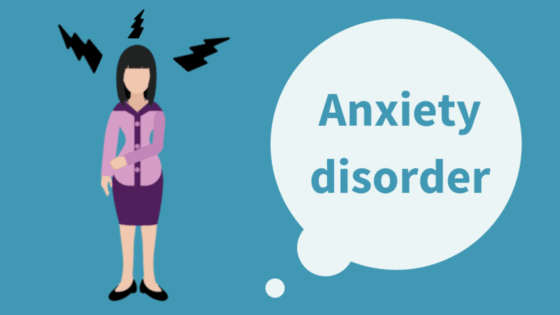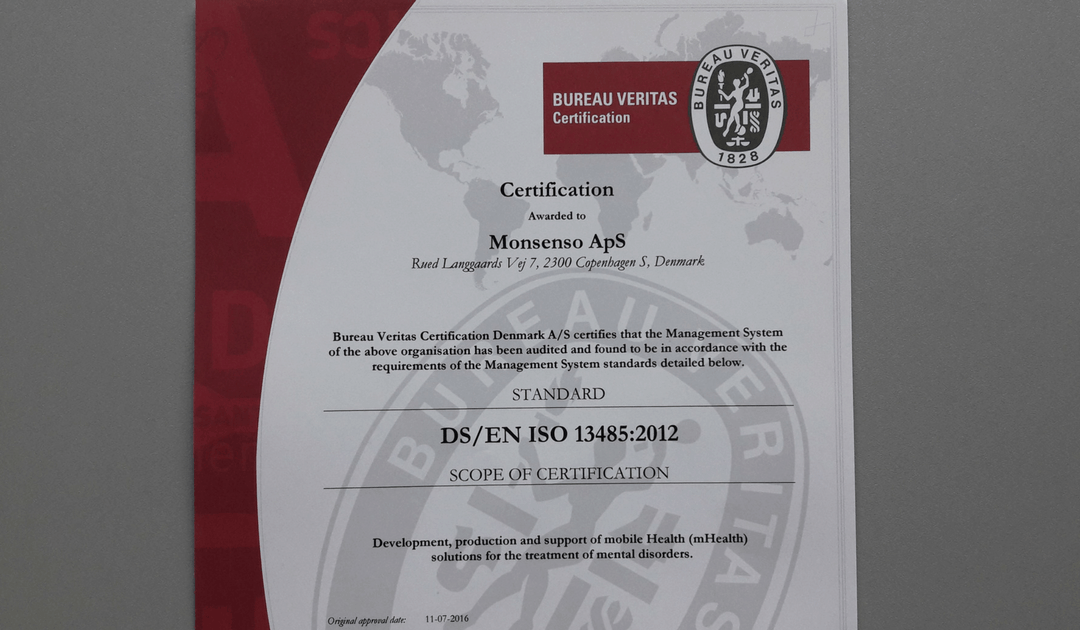
by Thomas Lethenborg | Aug 21, 2020 | News
Quality Policy and Standards
As a technology leader in mobile health (mHealth) solutions for mental health, Monsenso is ISO 13485 certified.
ISO 13485 is the gold standard for medical device companies to ensure the quality, safety and efficacy of products in the medical device field. This certification ensures that the product in question, consistently meets customer requirements and regulatory requirements applicable to medical devices and other related services.
“Monsenso adheres to the highest security standards. Beyond, being ISO 13485, Monsenso holds the ISO 27001 certifications, a TGA certification and class 1 CE mark.” says Thomas Lethenborg, CEO at Monsenso.
You can download this article as PDF in English.
For additional information contact:
Bettina van Wylich
Chief Marketing Officer
Monsenso
+45 22704724
wylich-muxoll@monsenso.com
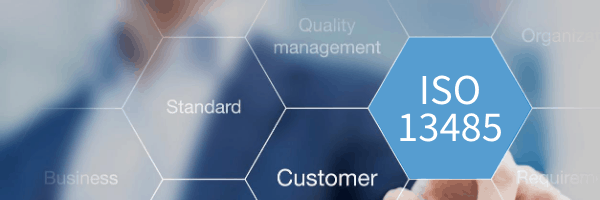
by Thomas Lethenborg | Aug 21, 2020 | News, Press releases
Quality Policy and Standards
As a technology leader in mobile health (mHealth) solutions for mental health, Monsenso is ISO 13485 certified. ISO 13485 is the gold standard for medical device companies to ensure the quality, safety and efficacy of products in the medical device field. This certification ensures that the product in question, consistently meets customer requirements and regulatory requirements applicable to medical devices and other related services.
“Monsenso adheres to the highest security standards. Beyond, being ISO 13485 certified, Monsenso holds the ISO 27001 certification and class 1 CE mark.” says Thomas Lethenborg, CEO at Monsenso.

For additional information contact:
Jennifer Highland
Marketing and Communications Manager
Monsenso
+45 81 71 7713
highland@monsenso.com
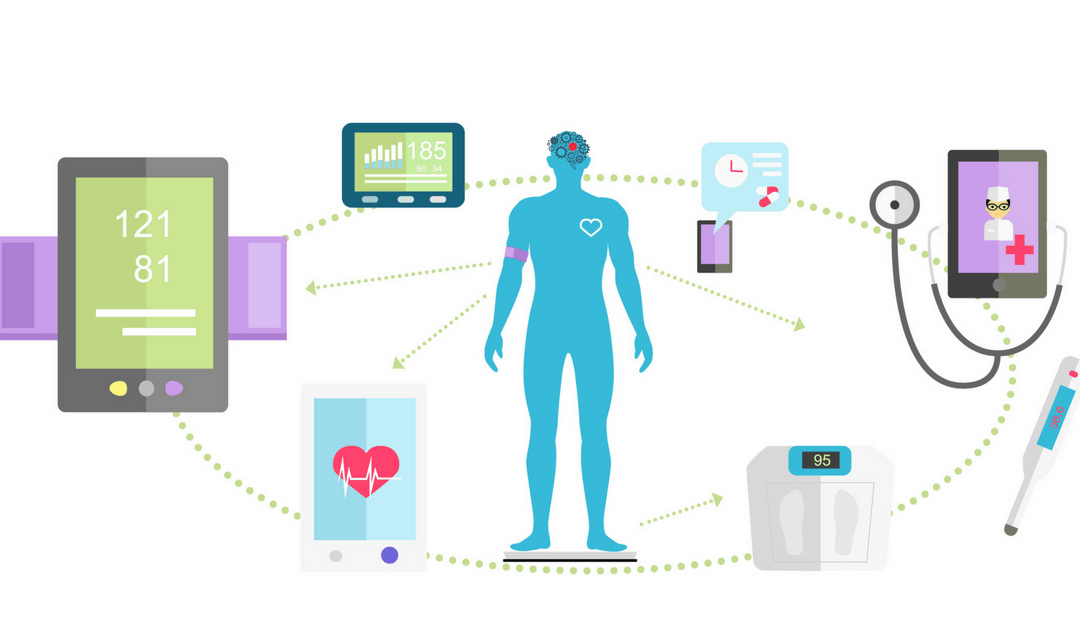
by Thomas Lethenborg | Sep 14, 2016 | Blog, mHealth
Approximately 450 million people worldwide suffer from mental disorders. One fifth of teenagers under the age of 18 suffer from developmental, emotional or behavioural problems, and one in eight have a mental disorder. Five of the ten leading causes of disability worldwide are psychiatric conditions, including depression, alcohol abuse, schizophrenia, and obsessive compulsive disorder. [1]
The Institute of Medicine Report has proposed a framework of mental health intervention for mental illness based on the classification and the public health distinctions between primary, secondary and tertiary prevention. [1]
Primary prevention focuses on promoting mental well-being, and decreasing adverse conditions such as child abuse, violence, discrimination, poverty, and lack of education to the general population. It also seeks to target individuals or subgroups of the population whose risk of developing a mental illness is higher due to biological, psychological or social risk factors.
Secondary prevention seeks to reduce the symptoms and decrease the number of episodes through early detection and treatment. [1]
Tertiary prevention includes interventions that reduce disability, enhance rehabilitation, and prevent relapses and recurrences of the illness. [1]
A Dutch study found a 50% reduction in the incidence of major depression among mildly depressed primary care patients who received a stepped-care intervention, compared with the incidence among primary care patients who received treatment as usual. Other studies showed that low-dose antidepressants or problem-solving therapy helped reduce the incidence of major and minor depression in post-stroke patients. [2]
Preventive measures such as mental health promotion and early intervention are the most cost-effective way to tackle mental illness on a global scale. Research reveals that common mental disorders such as depression and anxiety can be prevented. For instance, Cognitive Behavioural Therapy (CBT) has proven to be useful for people who already have mild depressive symptoms.
During the last few years, technology has crossed a new frontier in mental health support and data collection. Mobile health (mHealth technology) provides doctors, researchers and the general population with new ways to monitor a patient’s progress, access self-help tools, and increase understanding of mental wellbeing.
Mobile mental health support can be very simple but effective. For example, the Monsenso mHealth solution which consists of a smartphone app for patients and carers and web portal for clinicians uses self-reported data and the device’s built-in sensors to collect patient information. Based on the self-reported data, the Monsenso smartphone app identifies any triggers or warning signs, and it notifies patients and clinicians that help is needed before a crisis occurs. The Monsenso smartphone app also provides users with self-help tools that are always available in case of an emergency.
Although there are many mental health apps available on both the iTunes and Android app stores, this new technology includes a lot of uncertainty. There isn’t enough information on the quality, security and effectiveness of the different apps available, which can confuse clinicians and users.
The advantages of mental health apps
Experts believe that technology has a lot of potential for users and clinicians. A few of the benefits of mobile care include:
- Convenience:Treatment can take place anytime and anywhere (e.g. at home in the middle of the night or on a bus on the way to work) and may be ideal for those who have trouble with in-person appointments.
- Anonymity:Clients can seek treatment options without involving other people.
- An introduction to care: Technology may be a good first step for those who have avoided mental health care in the past.
- Lower cost: Some apps are free or cost less than traditional care.
- Service to more people: Technology can help mental health providers offer treatment to people in remote areas or to many people in times of sudden need (for example following a natural disaster or terror attack).
- Interest: Some technologies might be more appealing than traditional treatment methods, which may encourage clients to continue therapy.
- 24-hour monitoring: Technology can provide round-the-clock monitoring and self-help tools or interventions.
- Consistency: Technology can offer the same treatment plan to all users.
- Support: Technology can complement traditional therapy by extending an in-person session, reinforcing new skills, and providing support and monitoring. [3]
Trends in smartphone apps for mental health
- Self-management apps
Users enter self-reported data into the app so it can provide feedback. For example, medication reminders, stress-coping strategies or sleep problems. Some apps can also track sensor data and may help users monitor their progress and receive feedback.
- Apps to improve thinking skills and skills training
Apps that help users with improved thinking skills (cognitive remediation) and learn new coping or thinking skills. For example, they provide educational videos about anxiety management or the importance of social support. Additionally, users might pick up some new skills and use the app to practice those skills. This type of app may feel a little bit like a game, and often target people with severe mental illness.
- Supported care
This type of app allows users to interact with a trained health care provider or a peer support group who can offer guidance in case of an emergency.
- Monitoring and data collection
This type of mental health app can collect two types of data. On one hand, it gathers data using the sensors built into smartphones such as movement patterns, social interactions, behaviour at different times of the day, speech patterns and more. On the other hand, it collects self-reported data in the form of a mood diary or electronic questionnaire.
Although mental health apps may not replace mental health professionals, they allow clinicians to provide better support to more people regardless of their geographical location.
References:
[1] Prevention of mental disorders. Effective interventions and policy options. World Health Organisation. http://www.who.int/mental_health/evidence/en/prevention_of_mental_disorders_sr.pdf
[2] The future looks promising for mental health prevention. Psychiatric News. Joan Arehart-Treichel. 2013 (January 18). http://psychnews.psychiatryonline.org/doi/10.1176/appi.pn.2013.10b1
[3] Technology and the future of mental health treatment. National Institute of Mental Health. http://www.nimh.nih.gov/health/topics/technology-and-the-future-of-mental-health-treatment/index.shtml
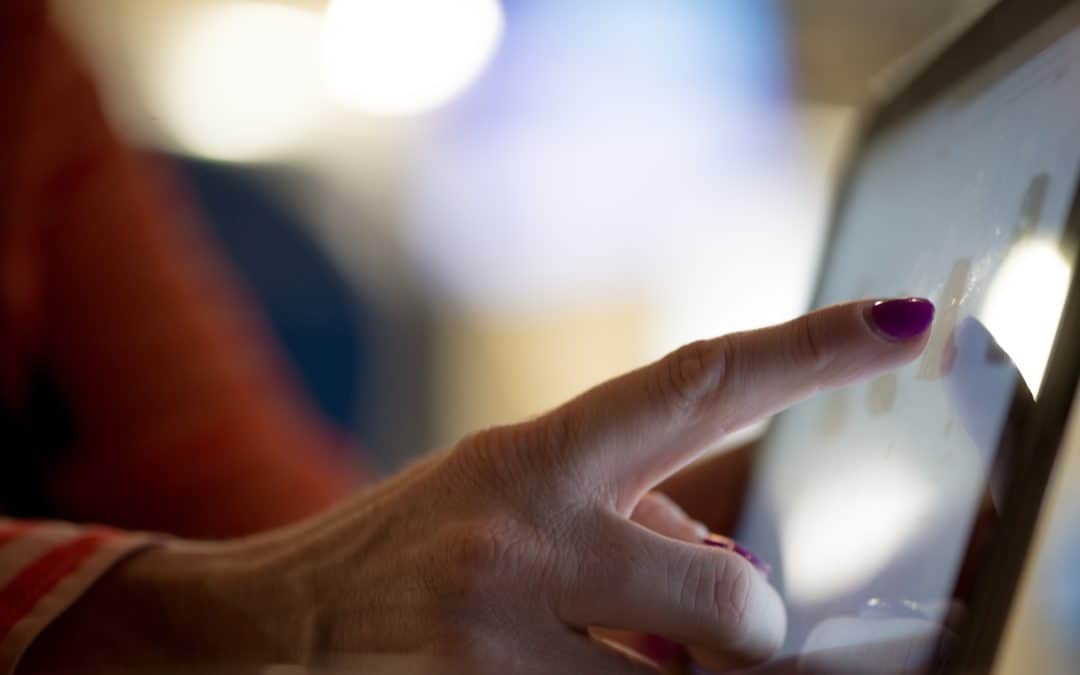
by Thomas Lethenborg | Jun 21, 2016 | Blog, Mental Illness, mHealth
According to a recent statement by the new American Heart Association (AHA), major depressive disorder and bipolar disorder should be recognized as moderate risk factors for atherosclerosis and early cardiovascular disease. [1]
In 2011, the National Heart, Lung and Blood Institute identified four conditions (chronic inflammatory disease, human immunodeficiency virus, Kawasaki disease, and nephritic syndrome) that lead youths to a mild risk of developing cardiovascular disease before they reach 30. [2]
The statement released a few days ago, reveals that depression and bipolar disorder meet the same criteria as these conditions. Moreover, these two behavioural disorders are more widespread than the previous mentioned conditions combined.
These studies showed evidence of a link between paediatric depression and bipolar disorder with premature cardiovascular mortality. Cardiovascular risk factors for these teens include obesity, insulin resistance and diabetes, dyslipidemia, and hypertension.[1] According to the statement, depression and bipolar disorder are the first- and fourth-most disabling conditions, among adolescents worldwide.
After the report had been unveiled, researchers from schools around the U.S. and Canada looked at existing studies on mood disorders in people under the age of 30. Researchers looked specifically into youths suffering from depression or bipolar disorder with cardiovascular markers such as high pressure and cholesterol. They found a significant connection between having depression or bipolar disorder and increased odds of high blood pressure, high cholesterol, obesity (especially belly fat), type 2 diabetes, and hardening of the arteries. [3]
This discovery denotes that healthcare providers should track physical activity levels and food intake as well as metabolic monitoring is crucial for these young patients as a preventive measure.
However, to monitor cardiovascular markers, physical activity and food intake, of thousands of young patients who also suffer from mental illness is not an easy task. Although, there are hundreds of smartphone applications tracking physical activity and counting calories, these apps are personal, and clinicians do not have access to an individual’s data. Nevertheless, with the Monsenso mobile health (mHealth) solution, this cumbersome task becomes easy and achievable.
The Monsenso mHealth solution enables clinicians to access a patient’s data on a daily basis. Every day, youths would be reminded to fill in a self-assessment with important information that could include the number of hours they slept, the amount of unhealthy food they have eaten, and if they realized any physical activity throughout their day. Additionally, the smartphone can also collect physical activity and mobility data, based on the smartphone’s inbuilt accelerometer and GPS locator.
The Monsenso mHealth solution, especially designed to monitor behavioural data of patients suffering from mental illness, can in this way help clinicians monitor any unhealthy habits of patients with risk of developing cardiovascular disease.
Further, with the customisable action plans, each youth could follow “contingency plans” if they experience some symptoms related to their mental illness or if they have engaged in unhealthy activities. For example, a special trigger could set up if a youth has indulged in unhealthy food for several days in a row, or has had a low level of physical activity. The action plan listed for this trigger could then encourage individuals to engage in physical activities and and to try to avoid sugar and fat during the upcoming week.
References:
[1] Browser,D Medscape. Depression, Bipolar Disorder in Teens are CVD Risk Factors: AHA (2015, August 10) http://www.medscape.com/viewarticle/849312
[2] American Heart Association. Young people with mood disorders have increased risk of developing early cardiovascular disease (2015, August 11)
http://blog.heart.org/young-people-with-mood-disorders-have-increased-risk-of-developing-early-cardiovascular-disease/
[3] Walton, A Forbes. Teens with depression, bipolar disorder, should be screened for heart disease, experts say. (2015, August 11) http://www.forbes.com/sites/alicegwalton/2015/08/11/depressed-teens-may-be-at-higher-risk-for-heart-disease/
Goldstein BI, Carnethon MR, Matthews KA, et al. Major depressive disorder and bipolar disorder predispose youth to accelerated atherosclerosis and early cardiovascular disease. Circulation 2015.






